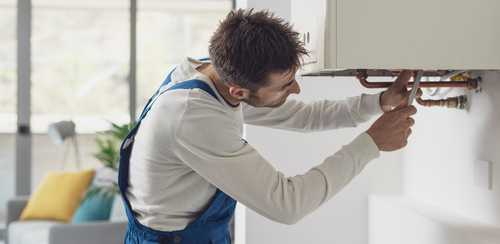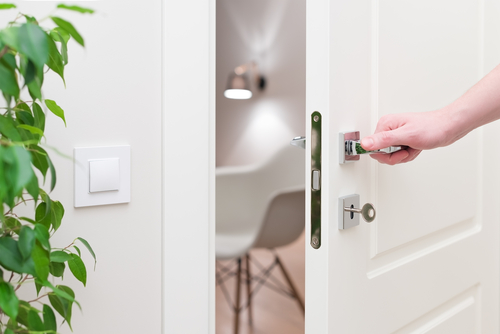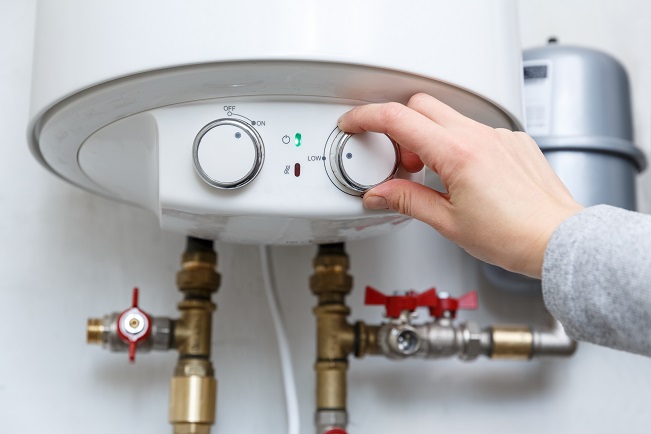It’s never too early to get your home ready for cold weather – especially in the UK’s unpredictable climate. Did you know that heating and hot water account for over half of what you spend on your energy bills? In April 2022, household energy bills increased by 54% and then rose by 27% more in October 2022. So even small improvements to your heating efficiency can bring big savings.
From boiler settings to insulation, here are our top tips on how to keep your house warm in winter.
1. Set your thermostat to the right temperature

Smart meters and thermostats can help you track your energy usage. A smart thermostat connects to your wifi and lets you change the settings on the go. You can control when your heating comes on and turn it up or down through an app on your mobile.
You should set your thermostat to the lowest temperature that’s comfortable for you. For most people, this is between 18 °C and 21 °C. According to the World Health Organisation, a slightly higher minimum temperature could be necessary for older adults, children, and anyone unwell.
The Lullaby Trust advise that babies sleep in a temperature between 16 °C and 20 °C. This is because overheating can increase the risk of sudden infant death syndrome.
2. Draught-proof your home
We’ve all felt those annoying draughts in our home at some point. Cold air can sneak in through gaps around windows and doors, as well as through keyholes and letterboxes.
Which? estimates that draught-proofing windows and doors could save you around £20 a year. With some basic DIY skills you can do the draught-proofing yourself. Or it will cost you about £200 to get a professional to draught-proof an average semi-detached house.
For draught-proofing tips to shut out the cold, see our guide on how to insulate your home for winter to save money and energy.
3. Insulate your pipes
Pipe insulation is another job you can do yourself if your pipes are accessible. Most pipe insulation (or lagging) consists of a foam tube that covers the exposed pipes between your hot water cylinder and boiler. This reduces heat loss and keeps your water hotter for longer.
It can cost anywhere between 40p to £2.50 to insulate a pipe depending on the thickness you choose. All you need to do is buy the right size of foam tube and fit it around the pipe yourself. Polyethylene pipe insulation is generally the cheapest option available. This consists of a hollow foam tube with a slit down one side to allow it to fit over existing pipework.
It can be difficult to insulate pipes due to their location (for example, under floorboards). If you want to get those insulated, you’ll likely need a professional.
4. Flush your radiators
Your radiators are the foot soldiers of your central heating system so it’s vital to keep them in good health. After years of dutiful service, it’s normal for them to get clogged up with dirt, sludge, rust and debris. When this stuff builds up, it stops heat flowing around and leads to cold spots. If left unchecked, this residue can also cause blockages, corrosion and poor efficiency.
If you want the ultimate clean for your heating system, you should consider a power flush. This is a powerful pump which pushes a blend of cleaning chemicals through your heating system. It will remove limescale, prevent rust and dislodge all that unpleasant residue.
A power flush normally takes about a day to do (depending on how many radiators there are in your house). The cost depends on that too, but the average household can expect to pay around £300. And while there are kits you can buy to do it yourself, it’s probably a job best left to the professionals.
5. Check your boiler's manual
If you’ve got a new boiler or have just moved into a new home, it’s worth checking the boiler manual. You can always order or download a new manual from the manufacturer if you’ve lost the original.
The manual can help you adjust your boiler settings to save some money on your heating. Plus, you might be able to solve small issues yourself, without needing to book an engineer.
6. Get your boiler serviced

When your boiler and heating system are working at their best, you’ll save on wasted energy. To ensure your boiler is running efficiently, get a Gas Safe engineer to service it once a year.
The engineer will test and clean your boiler, highlighting any issues before they can cause a breakdown. This will save you money in the long run and reduce the potential risk to your home.
We cover all the reasons why you should book a boiler annual service and what to expect.
7. Don’t obstruct your radiators
It’s easy to dry clothes on the radiator, but it also stops heat circulating around the room. Try not to cover your radiators with things like curtains, clothes or towels. Don’t put furniture too close either, as this will also block the heat.
8. Time your heating to come on when you need it
If you have your heating on a set temperature all the time, you might be wasting energy. With a timer, you can make sure it only comes on when you need it. For example, you might set a timer to come on half an hour before you wake up. If you go out to work, have the heating come on again half an hour before you come home. That way, you’re not heating an empty house.
9. Reflect heat back into the room
Putting something reflective on the wall behind a radiator can help keep the heat in the room. This is most effective for radiators on walls that are exposed to the outside.
You can buy radiator foil for around £7 a roll from DIY stores or builders’ merchants. Or to make your own, simply cut cardboard to fit the space and cover it with tin foil.
10. Close internal doors

Radiators and heaters work by creating a convection current in a room. The hot air rises, crosses the room, cools and sinks down. From there it travels back along the floor to the heater, where it’s heated again.
If a door’s open, this heat cycle won’t work as well, because the hot air won’t come back to the heater. So by closing the door, you’re maximising the effect of your heating.
11. Plug the gaps in your floorboards
Floorboards aren’t the first place we check when trying to stop heat escaping. However, an uninsulated floor can be responsible for up to 20% of the heat loss in your home.
For larger gaps, you can use wood slivers or strips. They should be a little larger than the gap between each of the floorboards and of similar depth. For gaps less than 5 mm wide, you can buy a wood-coloured sealant filler for about £7. There’s also decorators’ caulk, which is a little cheaper and can be stained to match the wood.
Our blog is loaded with more related articles

Energy saving tips
How to insulate your home and save money
Just like we put on layers in winter, our houses need to wrap up too — that’s what insulation is for. By keeping th...
Read more

Boiler help and advice
The 3 types of boiler you need to know about
If you’re looking to learn exactly what a combi boiler is and how it differs from other types, read our guide on combi vs...
Read more

Boiler help and advice
How much does central heating cost to install?
A new central heating system can be costly but more cost-effective over time than running an old, inefficient system. Find out...
Read more
